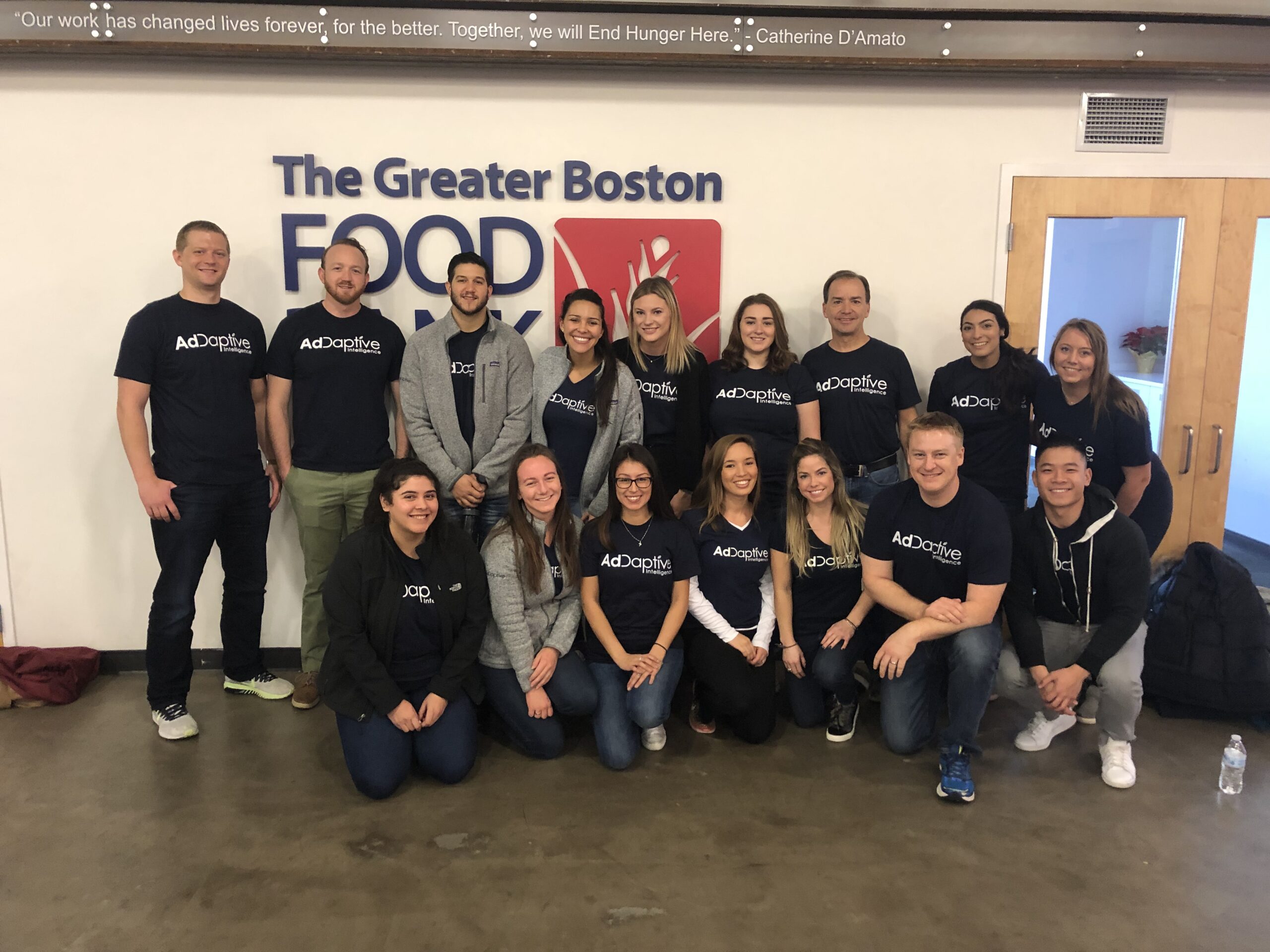AdDaptive Gives Back: Spreading Joy Through Community Involvement

AdDaptive Gives Back
On November 27, also known as Giving Tuesday, a group of employees from AdDaptive traveled to the Greater Boston Food Bank to help package, sort, and ship out donations. Our employees felt so rewarded giving back to the community and contributing their time and hard work for a worthy cause. They came together as a close-knit team with the greater good as their shared priority and put in manual labor to support a local initiative and provide relief to those in our community who need a helping hand.
The best part of all is that this was an initiative organized by our employees. Our team members’ passions drove this initiative and thus formed our corporate social responsibility stance, implementing bottom-up inspiration that grew out of their sincere will to do good. Thankfully, our leadership team supported the project and empowered employees to organize the initiative freely in the office, which gave some people the time and resources to do something they may not have been able to otherwise.
At AdDaptive, even as we scale, our community is always top of mind. In fact, we’re able to do more for our community as we expand outward. The more employees we have, the more wonderful ideas are generated, and the more people rally around a cause, work together to devise projects, and actively engage with the community. At companies with fewer employees, employees may want to do good but may have to wear so many hats that they may not have the time to pull their attention away from their multi-faceted responsibilities. But as companies grow and departments become more clearly defined in their roles and responsibilities, employees are able to feel trusted to do their work, and identify when they can take some time to give back to the community.
Corporate Social Responsibility
Corporate social responsibility, or CSR, refers to a business model involving a company being socially accountable for their impact on society. Oftentimes, this takes on two forms. First, some companies incorporate ethical practices into their operations to achieve goals such as privacy or safety for customers. For example, brands that create body products like soaps or lotions may adopt a CSR model and ensure their products are organic or do not harm animals during testing. In ad tech, it may manifest in a more subtle way, but companies may ensure data privacy to consumers (such as PII), or promise transparency to customers so as to prove they are only delivering ads to those who want to see them. The second form of CSR often involves some element of community service. Beyond doing “good” in their daily operations, companies will take time to go out into the community and give back actively, supporting local initiatives such as soup kitchens or school drives.
To all our business-minded readers, according to a previous McKinsey report, CSR tends to have a positive impact on a company in that it maintains a positive reputation and adds to brand equity. Furthermore, employees will be happier when they feel how rewarding it is to give back to the community and to be empowered by their employer to pursue socially responsible activities. Employees that feel supported by their employers will feel more empowered in the workplace, leading to higher productivity and lower turnover. Plus, it never hurt anyone to spread goodwill, especially around the holidays.
How to Set Up a CSR Initiative at Your Company
Focus
Being philanthropic is not about getting something in return – it’s about giving selflessly and not expecting anything back. Therefore, when your company wants to start a CSR initiative or incorporate CSR into its mission, decide how you are able to give back to your community, and what it means for you to be able to offer this to your employees. If your CSR focuses on a topic such as sustainability or privacy, it is possible to improve operational efficiency or even allocate budget and attribute revenues. But if it is not critical to your product offering, and is more of a community service initiative you’d like to offer to your employees, such as serving at a soup kitchen or local school, don’t tie it to the books.
Communicate
To illustrate CSR’s importance, include it in your mission, make it one of your core values, or make it an agenda item on your quarterly reviews or staff meetings. Some companies create a page on their website dedicated to the ways they give back to the community (some medical companies benefit from this type of external positioning). Your social offering can add to your brand equity, and can be an interesting offering that could attract new talent to want to work for your company.
Rally
Empower your employees to vote on or choose the organizations or causes. Participation will help them feel more engaged, and will help them feel more rewarded in the end. Articulate your company’s stance on social engagement and community involvement so everyone knows what the options are and how to get involved.
Making sure managers know how to speak with their team members about CSR initiatives and ensuring employees know how to manage their work around their community service will enable social engagement without risking productivity, benefitting all involved. That way, a company can give back without giving up valuable work time.
—
Bonus content: To Attribute or Not to Attribute
Some executives will ask: Does CSR need to be tied to business results? If CSR is critical to your product offering, the answer is most likely yes. For example, if your beauty care product being sustainable is vital to its competitive advantage, then yes, you may reduce costs, increase revenues, or enhance your brand based on this stance. But if you interpret CSR to involve one-off community service events, such as a walk to support a cause or Habitat for Humanity, your results cannot be measured by dollar value. In other words, you are not always going to be able to attribute a community service project to revenue. Instead, focus on a goal or a part of your mission you want to spotlight, and keep your community as well as your employees at the heart of your strategy. In this case, your best measure of success will be the happiness of your employees, so be sure to keep a pulse on what they enjoy about the CSR projects and what they’d like to do next to maintain the company’s social standing.








